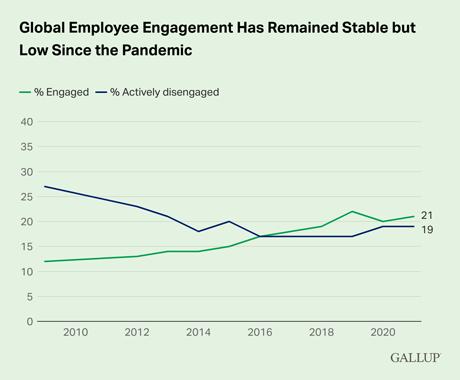Story Highlights
- At least half of the U.S. workforce is quiet quitting
- The workplace, amid the pandemic, got worse for younger workers
- Managers are essential to combatting quiet quitting
"Quiet quitters" make up at least 50% of the U.S. workforce -- probably more, Gallup finds.
The trend toward quiet quitting -- the idea spreading virally on social media that millions of people are not going above and beyond at work and just meeting their job description -- could get worse. This is a problem because most jobs today require some level of extra effort to collaborate with coworkers and meet customer needs.
U.S. employee engagement took another step backward during the second quarter of 2022, with the proportion of engaged workers remaining at 32% but the proportion of actively disengaged increasing to 18%. The ratio of engaged to actively disengaged employees is now 1.8 to 1, the lowest in almost a decade.
The drop in engagement began in the second half of 2021 and was concurrent with the rise in job resignations. Managers, among others, experienced the greatest drop.
The overall decline was especially related to clarity of expectations, opportunities to learn and grow, feeling cared about, and a connection to the organization's mission or purpose -- signaling a growing disconnect between employees and their employers.
Many quiet quitters fit Gallup's definition of being "not engaged" at work -- people who do the minimum required and are psychologically detached from their job. This describes half of the U.S. workforce.
Everyone else is either engaged (32%) or actively disengaged (18%). The latter are "loud quitters." Actively disengaged employees tend to have most of their workplace needs unmet and spread their dissatisfaction -- they have been the most vocal in TikTok posts that have generated millions of views and comments.
Most employees who are not engaged or actively disengaged are already looking for another job.
The Workplace Has Gotten Worse for Younger Employees
Gallup finds a decline in engagement and employer satisfaction among remote Gen Z and younger millennials -- those below age 35.
This is a significant change from pre-pandemic years. Since the pandemic, younger workers have declined significantly in feeling cared about and having opportunities to develop -- primarily from their manager.
These younger employee advantages have mostly disappeared.
- The percentage of engaged employees under the age of 35 dropped by four percentage points from 2019 to 2022. And during the same time, the percentage of actively disengaged employees increased by six points.
- Younger workers have dropped nine or more points in the percentage who strongly agree that someone cares about them, someone encourages their development, and they have opportunities to learn and grow.
- Fully remote and hybrid young workers dropped nine points in strong agreement that someone encourages their development.
- Disturbingly, less than four in 10 young remote or hybrid employees clearly know what is expected of them at work.
Solving the Quiet Quitting Crisis
It's clear that quiet quitting is a symptom of poor management.
First, address manager engagement. Only one in three managers are engaged at work. Senior leadership needs to reskill managers to win in the new hybrid environment.
Managers must learn how to have conversations to help employees reduce disengagement and burnout. Only managers are in a position to know employees as individuals -- their life situation, strengths and goals.
Gallup finds the best requirement and habit to develop for successful managers is having one meaningful conversation per week with each team member -- 15-30 minutes.
Managers need to create accountability for individual performance, team collaboration and customer value -- and employees must see how their work contributes to the organization's larger purpose. Decisions about where people work -- on-site, remote or a hybrid schedule -- should keep these factors in mind. Importantly, every organization needs a culture in which people are engaged and feel they belong.
Gallup's findings are based on a random sample of 15,091 full- and part-time U.S. employees aged 18 and over, surveyed in June of 2022.
Build an engaged workforce that goes the extra mile:
- Learn what employee engagement means and how to improve it.
- Partner with Gallup to discover what your employees need to succeed.
- Explore the Q12, Gallup's science-backed survey for measuring employee engagement.




